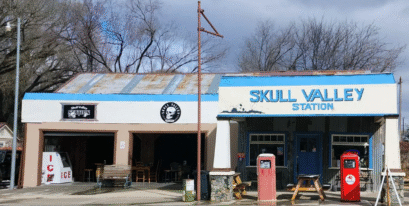The Human factors:
- Gold was discovered on Lynx creek by the Walker Party in 1863.
2. Arizona’s Territorial Capitol established in Prescott.
3. Military protection against the Indian raids improved, and was no longer an issue after the mid 1870’s.
4. Skull Valley was located along the main transportation wagon trail from La Paz to Prescott, one day’s travel SW of Prescott.
5. The Peavine Railroad was built through Skull Valley in May 1894, interconnecting the two mainline transcontinental (East to West) Railroad systems.
The Natural resources factors:
- Water and animal forage: Seasonal stream flows down Ferguson Valley wash into Coughran’s canyon appears to supply waters to local springs, marshes and ponds & what used to be artesian wells in the lower valley. Occasional flood flows during summer rain storms not only adds water to the valley’s underground reservoir , but also sends water on down the system to Kirkland creek and on into the Santa Maria river. Several irrigation wells supply water for sprinkler or flood irrigation that increasing forage production for livestock and wildlife.
- During early geologic events that formed this valley, volcanic forces pushed up the rounded Domes of Bald Mountain and Martin Mountain to the west along with some pointed craters cones. The lava flows formed the black squares basaltic ridges on Martin Mountain.

The light tan volcanic flows formed deposits near the valley bottom locally known as Tufa, or Tuff stone. These are composed of volcanic ash mixed with very small stones or gravels. As they pushed up to the surface and begin rapid cooling they become hard like concrete.
Some of the early residents (Rudy & Rynerson) South of the main valley developed a quarry on Bureau of Land Management (Federal) lands, and sold these air hardened cut stones for building blocks. Part of the State Capitol building in Phoenix was constructed with blocks of Tuff stone from Skull Valley.
Some commercial buildings in Prescott as well as a few homes in this area of Yavapai County were also built from this quarry. To the East, the Bradshaw Mountains were formed during fault block uplifts. During this Mountain forming process immense pressure and temperatures were generated and are thought to have caused the mineral deposits of Copper, Silver, Gold, Nickel and possibly, platinum, sought after in the Copper Basin mining area.
- Wealth from mining operations has been unpredictable, like the stock markets. Miners often turned to farming of the richer valley bottom soils to help feed their families and to sell the surplus to their neighbors or to the military.The Hannan family operated a dairy and Alfred M. Christopherson worked there in the late 1920’s, Patsy Christopherson tells of being born there in a tent with a wooden floor, in 1926.

The D’Armonds also operated a dairy further north, on the Crapo Homestead.

There remains today a tall cement silo at the Hannan Dairy (now Jenner’s). The cement building at the former Walter Raber’s place [Hankin Place] was built for a cheese factory, later used as a residence where Lucille Patton was born.
- Federal and State public lands surround this valley and they lend themselves to Mining or Cattle & Sheep or Angora Goat Ranching.

If you own private base operational lands near these public Lands, then you may qualify for leases for grazing of these large tracts of public lands, at a bargain price.
 There was a lot of Angora goat raising in this area in the first half of the 20th century, primarily for their high quality wool.
There was a lot of Angora goat raising in this area in the first half of the 20th century, primarily for their high quality wool.
Shearing operations were on the Jack Medd Ranch near the North end of the valley. (A bar V Ranch)
- Skull Valley’s “Boom”, about busted the School!
The Commercial Mine in Copper Basin East of the valley, cranked up operations in 1920, and sent ten mule teams from Prescott to start hauling 50 to 100 tons of ore per day down to the ore loading ramp on the Railroad in Skull Valley.
The Laswells owned the former Dickson Stage station and blacksmith shop. Mrs. Laswell fed the muleskinners and most of them found room in the Russell Hotel or with private homes. Laswell’s corralled and fed the mules & probably had more business than he’d seen in several years.
The student population went from 30 to 63 almost overnight and the local one room school was quickly expanded to two rooms. This building is now the Skull Valley Community Hall.
